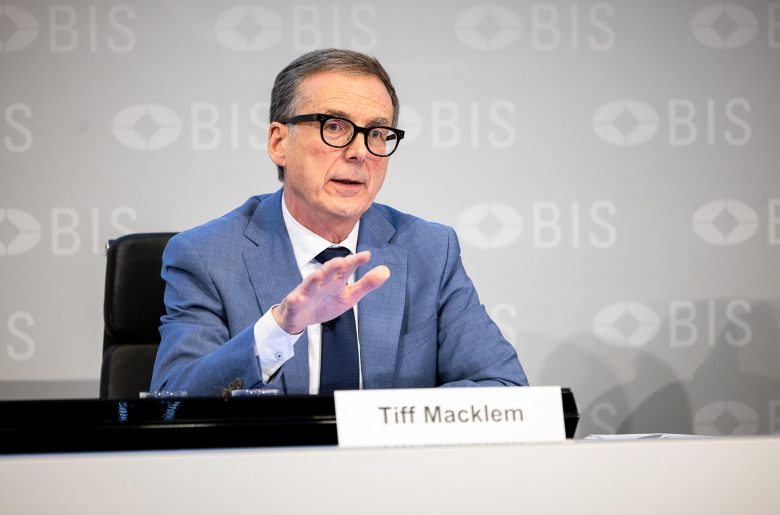
Governor’s foreword
In 2023, the Bank of Canada made considerable progress in the fight against inflation and laid the groundwork for the return to price stability. But even as inflation came down considerably, increases in the cost of living continued to squeeze Canadians. For many, higher interest rates added to their burden. The challenge for the Bank was to set our policy interest rate high enough to wring high inflation out of the economy, but not so high that we stifled it. Global events ranging from foreign bank failures to the war in Israel and Gaza added uncertainty and brought new risks.
Through the year, monetary policy worked to moderate spending, rebalance the economy and relieve price pressures. Inflation came down from a peak of 8.1% in 2022 to 3.4% in December 2023, and we expect inflation to ease further in 2024. At year’s end, the economy was no longer in excess demand. The labour market, which was very overheated in 2022, had come into better balance and the unemployment rate was where it was just before the COVID‑19 pandemic.
The economy saw some volatility in inflation. The consumer price index fell to 2.8% mid-year and then rose to 4% before easing back to 3.4% at the end of 2023. Canadians can expect more pushing and pulling on inflation through 2024, as weak growth relieves price pressures but tightness in some sectors exerts upward pressure on prices. The Bank of Canada will set monetary policy carefully, but we will not waver in our resolve to restore price stability for Canadians.
In 2023, we were reminded that financial instability can strike quickly, and the Bank needs to be prepared to respond. In March, bank failures in the United States and Switzerland shook the global banking system. Strong international banking regulations, combined with swift action by US and Swiss authorities, avoided a wider crisis. Here in Canada, the financial system was stable, with very little spillover from global events. Nonetheless, the global failures were a stark reminder of the importance of fostering a stable financial system, and the Bank monitored the Canadian system closely for early signs of strain. We remain vigilant and have the tools to provide emergency liquidity to the financial system if severe stress were to develop.
The shared resolve to restore price stability and maintain financial stability is anchoring long-run inflation expectations and limiting contagion from financial instability events. The Bank of Canada is a strong voice at the international table on the joint imperatives of staying the course to price stability and fully implementing international standards for banks. However, conflicts and geopolitical tensions are increasing global fragmentation, making it harder to achieve international consensus. This underscores the importance of multilateral institutions in maintaining a well-functioning international monetary system. The Bank of Canada continues to support the International Monetary Fund in its work.
Much of the Bank of Canada’s focus in 2023 was on managing immediate policy imperatives, but we also made important investments in the future. We invested in trust. We need to restore the trust we’ve lost because inflation has been too high for the past two years. We want diverse perspectives. We want to listen to and connect with more Canadians.
To achieve these goals, we strengthened our decision-making processes and improved our transparency and communications:
- We created a new role on Governing Council, and appointed economics professor Nicolas Vincent as an external, non-executive Deputy Governor for a term of two years.
- We began publishing summaries of Governing Council deliberations, providing more insight into the Bank’s monetary policy decisions.
- We provided more plain language summaries and short video clips on social media to explain our outlook for the economy.
- Members of Governing Council have been visiting communities across our vast country to listen to Canadians and learn more about how monetary policy is affecting them.
Beginning in 2024, we will take questions from the media after every scheduled rate announcement—not only those accompanied by a Monetary Policy Report. We want households, businesses and communities to understand the actions we are taking and why we are taking them.
We also invested in the tools and skills needed to operate in a world that is rapidly changing. It increasingly looks as though the world will be more prone to supply disruptions and shifts in economic relationships in the future. Climate change and rising geopolitical tensions will likely create new disruptions and new economic shifts. We are making our economic models more flexible to accommodate sudden shifts in economic conditions. The next generation of these models will analyze data on a more granular level and help us consider alternative risk scenarios.
Our responsibility is to ensure that Canada’s payment systems are prepared for the economy of today and tomorrow, and we invested in our digital future. That means being ready for the possibility that Canadians may want to hold central bank money in a digital form. We took an important step in 2023 by listening to Canadians and reporting back on our consultations on a Digital Canadian Dollar. Almost 90,000 Canadians responded to our public questionnaire. We heard how much they value their privacy and that they place a high value on holding money backed by the central bank.
We also heard clearly that Canadians still want the ability to use physical bank notes. We will continue to provide secure bank notes with features that prevent counterfeiting. With the coronation of a new monarch, His Majesty King Charles III will be featured on Canada’s next $20 bank note. Early preparations are underway to issue this new vertical polymer note, complete with the next generation of security features to protect it from counterfeiters.
The Bank also took steps to fulfill its new mandate to supervise retail payment service providers. In 2023, we:
- conducted outreach to payment service providers to ensure they understand their obligations under the Retail Payment Activities Act
- supported the Department of Finance Canada in developing supervisory policies and guidelines
- launched a website to explain the policies and practices the Bank will use to ensure payment service providers comply with requirements for managing operational risk and safeguarding end-user funds
In a year that saw many changes, some things stayed constant. Our employees remained our greatest strength, and we continue to invest in their well-being. The Bank was named one of Canada’s Top 100 Employers for the 14th consecutive year. Over 80% of our employees said they would recommend the Bank as a great place to work, and 86% said they felt supported by their leaders. We’re proud of that, but we did not stand still. We continued to foster greater equity, diversity and inclusion. We are enhancing our analysis of human resources data to better understand and address the root causes of pay gaps for equity-seeking groups.
The coming year promises to be one of transition. The effects of past interest rate increases will continue to work their way through the economy, restraining spending and limiting growth and employment. This will not feel good. But by the end of 2024, we expect inflation will be closer to our 2% target, growth will be picking up and businesses will be expanding their hiring plans.
We know we need to be ready for new developments. We won’t be able to forecast them all—there are certain to be bumps in the road and new surprises. We should be humble about our forecasts and nimble when required. And, critically, we must learn from the high inflation we’ve experienced recently, so that we can come out of this difficult period better prepared for what lies ahead.
Tiff Macklem
Governor

